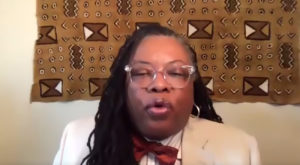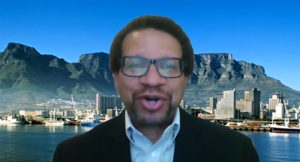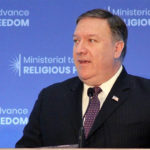Four Black scholars offered perspectives on religious freedom informed by the experiences of African Americans during a lecture series sponsored by the Baptist Joint Committee for Religious Liberty.
Nicole Myers Turner of Yale University, Teresa Smallwood of Vanderbilt University Divinity School, Anthony Pinn of Rice University and David Goatley of Duke Divinity School delivered the Walter B. and Kay W. Shurden Lectures on Religious Liberty and Separation of Church and State.
“Religious liberty has been white too long” was the theme of the online lectures, presented April 14.
Turner examined how recently freed 19th century Black Baptists defined religious liberty in ways that offered a critique of racial inequality.
Religious freedom as soul liberty
“For them, religious freedom was about fundamental soul liberty, and that was what they had to protect and wrestle away from the system of inequality that had so long denied enslaved people their fundamental humanity,” she said.
She focused on Fields Cook, who was born into slavery on a King William County, Va., plantation in 1817.
At an early age, Cook “came to understand the grievous sin of the institution of slavery, namely that it denied enslaved people the right to pursue their soul’s salvation just because they were slaves,” Turner said.
In time, slavery denied Cook the opportunity “to pursue his soul’s highest calling, to become a minister of the gospel,” she said.
“Slavery dealt its severest spiritual blow by denying Fields and other enslaved people the freedom to follow God and tend to their souls’ salvation,” Turner observed.
Sign up for our weekly edition and get all our headlines in your inbox on Thursdays
In a brief memoir Cook began writing at about the time he purchased his freedom, he began to critique slavery as an institution that denied enslaved people religious liberty.
“Fields Cook’s narrative and critique of slavery offers an entry point for redefining religious freedom through the eyes of freed people,” Turner said. “From Fields’ account, religious freedom was soul liberty—the freedom to live out one’s calling without hindrance.”
As Cook told his personal story, he used religious freedom to critique racial inequality “that denied enslaved and freed people the fullest and deepest expression of their humanity because of their status as slaves,” Turner added.
Religious freedom and political critique intersected in the Black churches formerly enslaved people founded, Turner noted.
Fields Cook and other freed people “infused their post-emancipation activities with a sense of purpose, challenging inequality and injustice where it existed and securing for themselves soul liberty,” she said.
The veil as a deep symbol of religious freedom
Smallwood used the veil in the Jerusalem temple—torn from top to bottom at Jesus’ crucifixion, as recorded in Matthew 27:51—to symbolize Black Americans’ experience with religious freedom.

“Deep symbols permeate the theological and biblical landscape as markers for meaning and purpose,” Smallwood said. The veil serves as a symbol both of what is hidden and what is revealed, she added.
Smallwood cited Dogged Strength within the Veil by Josiah Ulysses Young, professor of systematic theology at Wesley Theological Seminary, to describe the torn veil as “a deep symbol of religious freedom” for Black Americans.
“The tearing of the veil from the top is evident most prominently where African Americans mastered every rationality, communion and convention known to American life to the point of conquering the highest offices in the land,” Smallwood said.
“Demonstrably, the veil is torn from the bottom when we consider that African Americans have been pinned to the ground by knees on their necks, pressing the very breath of life from their bodies. And yet, the death which ensues shifts the atmosphere in policy and culture around the nation and the world. …
“In effect, it is this deep symbol of religious freedom that catapults veiled subjects to a place of unveiling where liberative connections are made for African American humanity’s wholeness and healing.”
The torn veil allows access to God, the source of power and freedom, Smallwood asserted.
“The ground has shifted, and the veil is torn, because we have learned as a people to operate in the power of the Spirit, and that is religious freedom,” she said.
‘How does it feel to be a problem?’
Pinn explored a question initially raised by author and activist W.E.B. Du Bois regarding Black Americans. “It’s a question that guides the cultural constructions that mark the life geography of Black communities: How does it feel to be a problem?”

From their earliest days in what became the United States, sold as enslaved people on the auction blocks, Blacks have been dehumanized and marginalized, he said.
Black Americans have responded by appealing to religion, which Pinn broadly defined to include a variety of expressions and ways of wrestling with life’s greatest questions—both inside and outside conventional religious organizations.
Black religion is a “poetic encounter” that takes language and deconstructs it “in order to free it to speak a different truth,” he said. As examples, he cited hip-hop artists Tupac Shakur, Queen Latifah, Jay-Z and Kanye West.
“Here you get these artists reconceiving and rethinking moral and ethical obligations in a way that centers life, and they do this without ignoring and without denying the messy and tense nature of our collective dealings,” Pinn said
“From my vantage point, this is important stuff—that thinking in this much broader way that recognizes there are tensions, inconsistencies and conflicts within the ways in which Black folks have wrestled with those fundamental questions gives us a greater sense of the contours and the content of liberty and freedom.”
‘Where one sits determine what one sees’
In the concluding lecture, Goatley directly addressed “white siblings” who are engaged in discussions regarding religious liberty.

Too often, religious liberty conversations in the United States have been dominated by white leaders on the extreme right or extreme left, speaking in ways “incongruent” with the experiences and beliefs of many Black Americans, he asserted.
He commended the BJC and its “reasoned” approach to religious liberty as holding greater “potential for partnership” with a broad spectrum of Black leaders, because it values both freedom of religion and freedom from religion without antagonism toward religion.
However, Goatley urged the BJC and likeminded groups to engage Black leaders in conversation before setting agendas rather than seeking their approval after the fact. Furthermore, he called on them to seek out a variety of Black voices—“not only the voices that are comfortable, but diverse voices that challenge, that test, that question.”
“White religious liberty leaders need to be cautious about assuming that, however well-thought and however well-argued, your perspective can speak for all. Where one sits determines what one sees,” he said. “And Black vision for religious liberty will enhance life for everyone.”














We seek to connect God’s story and God’s people around the world. To learn more about God’s story, click here.
Send comments and feedback to Eric Black, our editor. For comments to be published, please specify “letter to the editor.” Maximum length for publication is 300 words.